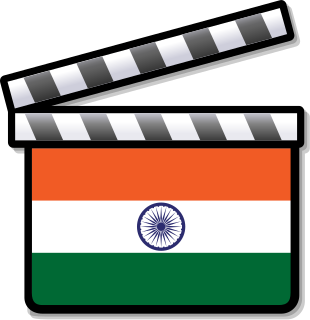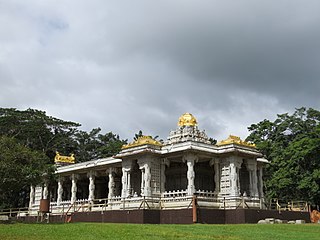Related Research Articles

Hindi cinema, often known as Bollywood and formerly as Bombay cinema, is the Indian Hindi-language film industry based in Mumbai. The term is a portmanteau of "Bombay" and "Hollywood". The industry is related to Cinema of South India and other Indian film industries, making up Indian cinema—the world's largest by number of feature films produced.

Although the United States does not have an official language, the most commonly used language is English, which is the de facto national language, and the only one spoken at home by approximately 78% of the U.S. population. Many other languages are also spoken at home, especially Spanish, according to the American Community Survey (ACS) of the U.S. Census Bureau; these include indigenous languages and languages brought to the U.S. by people from Europe, Africa, and Asia. However, the majority of speakers of these languages are bilingual and also speak English. Although 21.6% of U.S. residents report that they speak a language other than English at home, only 8.4% speak English less than "very well." Several other languages, notably creoles and sign languages, have developed in the United States. Approximately 430 languages are spoken or signed by the population, of which 176 are indigenous to the area. Fifty-two languages formerly spoken in the country's territory are now extinct.

Allah Rakha Rahman is an Indian film composer, record producer, singer and songwriter who works predominantly in Tamil and Hindi films. In 2010, the Indian government awarded him the Padma Bhushan, the nation's third-highest civilian award. Among Rahman's awards are six National Film Awards, two Academy Awards, two Grammy Awards, a BAFTA Award, a Golden Globe Award, fifteen Filmfare Awards and seventeen Filmfare Awards South.

The cinema of India consists of films produced in the nation of India. Cinema is immensely popular in India. Every year more than 1800 films get produced collectively in various languages in India. Mumbai, Chennai, Kolkata, Hyderabad, Kochi, Bangalore, Bhubaneshwar-Cuttack and Guwahati are the major centres of film production in India. As of 2013, India ranked first in terms of annual film output, followed by Nigeria, Hollywood and China. In 2012, India produced 1,602 feature films. The Indian film industry reached overall revenues of $1.86 billion in 2011. In 2015, India had a total box office gross of US$2.1 billion, the third largest in the world. In 2011, Indian cinema sold over 3.5 billion tickets worldwide, 900,000 more than Hollywood.

The film industry or motion picture industry comprises the technological and commercial institutions of filmmaking, i.e., film production companies, film studios, cinematography, animation, film production, screenwriting, pre-production, post production, film festivals, distribution and actors, film directors and other film crew personnel. Though the expense involved in making films almost immediately led film production to concentrate under the auspices of standing production companies, advances in affordable filmmaking equipment, as well as an expansion of opportunities to acquire investment capital from outside the film industry itself, have allowed independent film production to evolve.

Mehboob Khan was a pioneer producer-director of Indian cinema, best known for directing the social epic Mother India (1957), which won the Filmfare Awards for Best Film and Best Director, two National Film Awards, and was a nominee for the Academy Award for Best Foreign Language Film. He set up his production company – Mehboob Productions, and later a film studio – Mehboob Studios in Bandra, Mumbai in 1954. He also created the dacoit film genre with Aurat (1940) and Mother India, and is also known for other blockbusters including the romantic drama Andaz (1949), the swashbuckling musical Aan (1951), and the melodrama Amar (1954).

Krishnan Nair Shantakumari Chithra, credited as K. S. Chithra or Chithra, is an Indian playback singer and Carnatic musician. In a career spanning over four decades, she has recorded more than 25,000 songs in various Indian languages including Malayalam, Telugu, Tamil, Kannada, Hindi, Bengali, Oriya, Punjabi, Gujarati, Tulu, Rajasthani, Urdu, Sanskrit, and Badaga as well as foreign languages such as Malay, Latin, Arabic, Sinhalese, English and French. She is also known for her extensive history of collaboration in the songs with Music Composers A.R. Rahman, Ilaiyaraja, Hamsalekha, M. M. Keeravani and with the playback singers KJ Yesudas and SP Balasubramaniyam over the years. She is regarded as a cultural icon of Kerala and is fondly called as the Melody Queen and Nightingale of South India.
"American-Born Confused Desi" ("ABCD") is a term used to refer to South Asian Americans born or raised in the United States, in contrast to those who were born overseas and later settled in the USA.

Hinduism is a minority religion in the United States of America, ranking fourth largest, and constituting 1% of the population. The vast majority of American Hindus are immigrants from South Asia. There are also Hindus from Southeast Asia (mainly Singapore, Malaysia, Myanmar, Indonesia, Canada, the Caribbean, Oceania, Africa, Europe, and the Middle East, and other countries and their descendants. Additionally, the United States has number of converts to Hinduism. There are also about 900 ethnic Cham people from Vietnam, one of the few remaining non-Indic Hindus in the world, living in America, 55% of whom are Hindus.

Telugu cinema, also known as Tollywood, is the segment of Indian cinema dedicated to the production of motion pictures in the Telugu language, widely spoken in the states of Andhra Pradesh and Telangana. Telugu cinema is based in Film Nagar, a neighbourhood of Hyderabad, India. The nickname Tollywood is a portmanteau of the words Telugu and Hollywood.
Hyder Bilgrami is an Indian film director.

Indian Canadians are Canadians with ancestry from India. The term Indo-Canadian or East Indian, is sometimes used to avoid confusion with the Indigenous Peoples of Canada. Categorically, Indian Canadians comprise a subgroup of South Asian Canadians which is a further subgroup of Asian Canadians. According to Statistics Canada, Indian Canadians are one of the fastest growing communities in Canada, making up the second largest non-European group after Chinese Canadians.

Indian Americans or Indo-Americans are Americans with ancestry from India. The United States Census Bureau uses the term Asian Indian to avoid confusion with Native Americans. With a population of almost four million, Indian Americans make up 1.2% of the U.S. population and are the largest group of South Asian Americans and the second largest group of Asian Americans after Chinese Americans.
UTV Motion Pictures is the feature film unit of UTV Software Communications. UTV Motion Pictures is one of the leading film studios in India and one of the largest production studios in South Asia. The Studio's activities span creative development, production, marketing, distribution, licensing, merchandising and worldwide syndication of films in Indian territories. It is currently the distribution label of Disney for Walt Disney Studios Motion Pictures's feature films.

The Walt Disney Company India Private Limited, known simply as Disney India, is an Indian subsidiary of the Indo Pacific region of the American media and entertainment conglomerate The Walt Disney Company and headquartered in Mumbai, Maharashtra.

Dushyant Kumar was an Indian poet of modern Hindi literature. He is famous for writing Hindi Ghazals, and is generally recognised as one of the foremost Hindi poets of the 20th century.

Overseas Indians, officially known as Non-Resident Indians (NRIs) or Persons of Indian Origin (PIOs), are people of Indian birth, descent or origin who live outside the Republic of India. According to a Ministry of External Affairs report, there are 32 million NRIs and PIOs residing outside India.

Akkarakazhchakal: The Movie is a 2011 American Malayalam film based upon the popular TV series Akkara Kazhchakal.
There is a small community of Indians in Cambodia mainly expatriates and immigrants from India.

Gujarati Americans are Americans who trace their ancestry to Gujarat, India. They are a subgroup of Indian Americans.
References
- ↑ Fernandes, Venetia (20 November 2004). "Tale of injustice". Yahoo! India. Retrieved 10 January 2007.[ dead link ]
- ↑ Datta, Jyotirmoy (10 November 2004). "Now a 9/11 film, B'wood ishtyle". Times of India. Retrieved 10 January 2007.
- ↑ "Digimax Studio launches Bandhak (the hostage), the first Hindi film in US" (Press release). Digimax Studio. 23 December 2003. Archived from the original on 22 September 2006. Retrieved 10 January 2007.
- ↑ Jordan, Chris (9 September 2005). "Hindi film explores post-9/11 immigrant backlash". Home News Tribune. Retrieved 21 January 2007.[ dead link ]